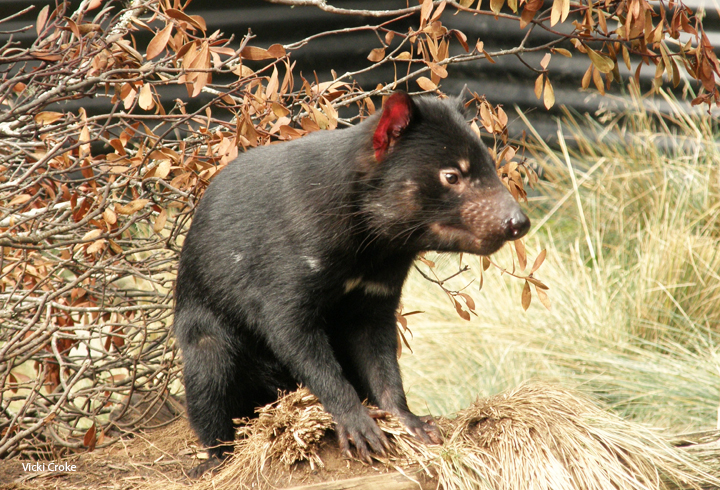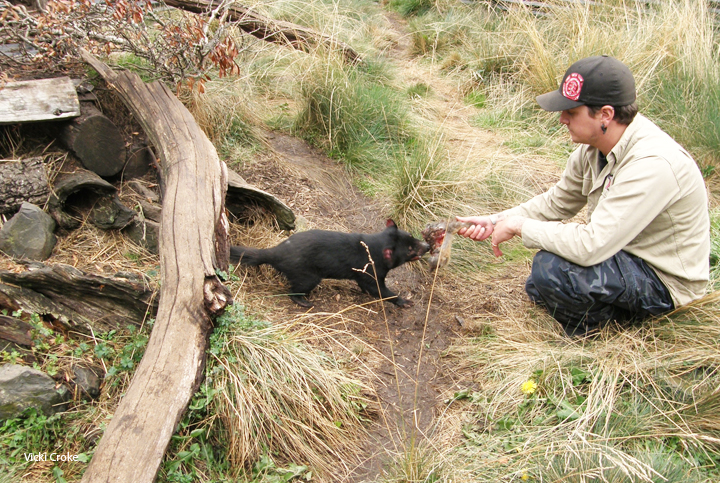Tasmanian Devil Killed By A Zoogoer?
The common enough danger for zoo animals, who cannot escape or fight back, is being taunted, harassed, or even intentionally harmed.
By Vicki Croke
Are the most dangerous animals at the zoo the humans?
News of an animal being intentionally harmed at a zoo is especially hard to take. Zoos and sanctuaries are supposed to be safe havens for the animals inside who can’t escape or fight back when humans want to do them harm.

This is one of the Tasmanian devils at the Cradle Mountain sanctuary in Tasmania, where Vicki reported on front-line efforts to save the species. Photo: Vicki Croke.
This week, a 4-year-old Tasmanian devil named Jasper at the Albuquerque Zoo was found dead in his exhibit in a pool of blood. The species is endangered and this animal was an important part of a breeding program. What seemed at first to be an attack from another devil—Jasper is one of four Tasmanian devils on loan at the zoo from a sanctuary in Australia—turned out to be something more sinister as the results of a necropsy or animal autopsy revealed.
According to Albuquerque’s KRQE News:
“It looks like there was malicious intent and essentially our poor Tasmanian devil was killed, intentionally, by what seems to be blunt force trauma to the head,” said the Mayor’s Chief of Staff Gilbert Montano.
According to a police report, a zoo keeper last saw Jasper alive around 4:30 Tuesday afternoon. Sometime between then and Wednesday morning, somebody threw pieces of asphalt at Jasper, hitting him in the head and killing him.
The city says the asphalt was four inches thick and the size of a dessert plate. The city has already brought in an independent investigator to help police figure out who did it.
Right now, both zoo visitors and zoo staff are being looked at as part of the investigation. KRQE News 13 is told there is surveillance video of the walkways near the enclosure but that’s not being released at this time. There were two boys and a man seen leaving the area Tuesday afternoon but police aren’t sure if they’re involved.
Evidence suggests that the animal dragged himself to another part of the enclosure before dying.
Jasper was part of a breeding program for an endangered species whose population in Tasmania has been decimated by a mysterious illness. As we’ve written here before:
The beautiful and much maligned marsupials have been dying of a strange and contagious cancer—called devil facial tumor disease—since 1996. Since that time as much as 70 percent of the population may have been lost.
The disease causes huge tumors on the animals’ faces and is spread when they bite each other, which happens often in competition around carcasses.
Only two zoos in the United States have Tasmanian devils. According to the Associated Press:
“Upon hearing about it, the mayor was shocked, outraged, extremely concerned,” said Gilbert Montaño, Mayor Richard Berry’s chief of staff. “These little guys are an endangered species.”…
“The whole idea to have the animals here was to create a breeding ground,” Montaño said. “We hope this doesn’t jeopardize our efforts to create a habitat for an endangered animal.”
According to the Australian Broadcasting Corporation, the perpetrator, if caught, could face up to 18 months in jail.

A Tasmanian devil takes an offering of meat from a caretaker at Cradle Mountain in Tasmania. Photo: Vicki Croke.
And much is being done to identify those who are responsible. The New York Post reports:
The New Mexico BioPark Society and Crime Stoppers are offering $4,000 and $1,000 rewards, respectively, for information leading to the arrest of anyone involved in Jasper’s death.
The incident reminded me of a day years ago when I was doing a story at the Bronx Zoo. While on zoo grounds, I heard that a female gorilla sustained a gash on her forehead from a visitor who lobbed a rock at her. The wound was severe enough to require stitches. I felt helpless, infuriated, and so shocked that anyone would come into the zoo to do animals harm.
It happens. Over the years there have been cases of people jeopardizing the safety of zoo animals who are often unable to flee or defend themselves. Most recently, this summer, partiers at nighttime events at the London Zoo poured beer over a tiger, stripped off clothes at the penguin pool, and broke glass on a snake enclosure.
In August, a woman climbed across a barrier to the giraffe exhibit at the Henry Villas Zoo in Madison, Wisconsin and got close enough to the sensitive animal to be kicked in the face.
She received several stitches and a citation for harassing a zoo animal. In a TV interview, she described the incident as a “pretty funny story.”
Apparently the animal’s hoof hit the fence first and deflected most of the powerful kick, which in the wild can do serious harm and even kill a predator like a lion.
One video, which surfaced in 2013 on Youtube, showed a zoo visitor harassing and pulling the tail of a tiger at the Henry Doorly Zoo in Omaha.
We know of incidents over the past few years in which zoogoers have ended up being killed inside tiger exhibits here in the United States and most recently in India.
There’s nothing new about it. Within weeks of the Philadelphia Zoo opening in 1874, a sloth had been poked to death by the umbrellas and canes of zoogoers.
Tony Vecchio, the head of the Jacksonville Zoo in Florida feels these incidents happen less often. He believes the public is more aware and empathetic toward animals. And he also thinks that charging admission–many older zoos were free–has had a positive effect. He may be onto something on that score. The woman involved in the giraffe incident in Wisconsin defended herself in part by saying that the zoo was free.
Still, some of the most uncivilized behavior at a zoo can be seen on the outside of the moats: human beings taunting animals, banging on glass, shouting.
At least in a video from the Dallas Zoo in which children are screaming, “You’re ugly!” at a gorilla on the opposite side of the safety glass, the animal does what the parents should have: he gets them to stop.
[youtube=https://www.youtube.com/watch?v=8aqDoPDgjco]
